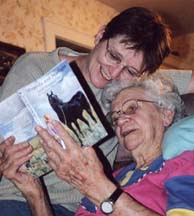I'm jumping into the middle of an issue with this post, and will come back later with more background from my workshop lesson on POV. For now, I want to relate an idea that I hope will help writers who struggle with this concept, hence this post.
When writing fiction, you must decide who is narrating the scene and stick with that person's point of view. You also have to decide how many points of view there will be in your book. There are many skilled authors who write from multiple view points successfully, but it's tricky for those who don't quite get what POV is all about.
I prefer to write entire books in third person but strictly from one narrator's POV. In the book I'm writing now, I switch viewpoints from chapter to chapter, but never mix them within a chapter. That will change when I get to the middle of the book and my two main characters meet and interact. Then there will be two points of view per chapter, but never more than one per scene.
I admit that I'm a stickler for adhering to one point of view per scene. You may ask, why bother? The advantage of a single or limited number of viewpoint characters, is that the reader finds it easier to follow the story, as well as to know, relate, and get into the body, heart, and mind of a character. As a general rule, the greater the number of characters from whose point of view you write, the less your reader will care about any one of them.
That isn't as important in the book I'm currently editing, because the protagonist is not a person, but a principle. The author has peopled his narrative and dialog with many POV characters. This actually makes writing and editing more difficult, because it becomes easier to mix points of view without realizing it. But for the sake of clarity and ease of reading, it is imperative to write each sentence, each paragraph, and each scene strictly in a single point of view.
When I've conducted workshops on fiction writing, I've found that the lesson on Point of View is often the most difficult for my students to grasp. As I lay awake last night contemplating this problem, I came up with an idea that might help writers who are grappling with the concept.
When struggling to see where you may have inadvertently mixed points of view, try this. Choose one character in the scene. Be that character. Switch to first person. Change every thing he does, says, or thinks to "I" and rewrite the scene. By doing so, you will more readily see from that character's eyes and eliminate other viewpoints. When finished, rewrite the scene in third person, with the corrections you made while writing in first.
For example, the following paragraph mixes two points of view.
Mary wanted to meet Paul, the new boy in her literature class, so badly she could taste it. And then, voila, just as she turned the corner on her way to Mr. Egland's Spanish class, she ran smack into him. Books flew. He stooped to pick up the papers scattered from both his and her notebook. He sorted them as quickly as possible, all the while worrying that he'd be late for Chemistry. Mrs. Dohner tolerated no tardiness.
Choosing one of the characters, I'll be Mary.
I wanted to meet Paul, the new boy in my literature class, so badly I could taste it. Then, voila, just as I turned the corner, heading for Mr. Egland's Spanish class, I ran smack into him. Our books flew. He stooped to pick up the papers scattered from both our notebooks. I knelt to help, searching for eye contact, but he would only look at the papers. Finally, thrusting a handful at me, he muttered as he sprinted away, "I can't be late. Mrs. Dohner will have my hide."
Then change it back to third person. (Mary, we realize, can't know what Paul is thinking unless he tells her.)
Mary wanted to meet Paul, the new boy in her literature class, so badly she could taste it. Then, voila, just as she turned the corner, heading for Mr. Egland's Spanish class, she ran smack into him. Their books flew. He stooped to pick up the papers scattered from both of their notebooks. Mary knelt to help, searching for eye contact, but he would only look at the papers. Finally, thrusting a handful of papers at her he muttered as he sprinted away, "I can't be late. Mrs. Dohner will have my hide."
I hope this helps. I'd like to hear your questions or comments.
Friday, September 16, 2011
Subscribe to:
Posts (Atom)

